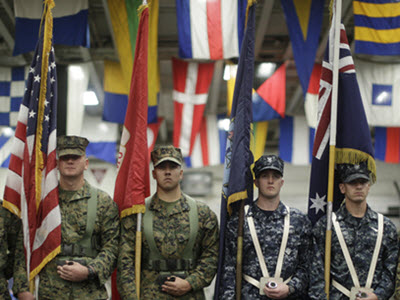New Security Challenges
Tests for the U.S.-Australia Alliance
Arzan Tarapore (NBR) examines recent changes in the regional security environment that pose challenges to Australian security policy and concludes that the U.S. alliance still offers the best prospect for Australia to weather these new challenges.
The alliance with the United States has been fundamental to Australia’s national security for decades. It has been not only the cornerstone of Australian hard power but also the critical enabling condition of other pillars of national security policy, including the country’s forward-defense posture and its investment in international institutions.
Australia has built its hard power around the alliance. Its military and intelligence services are deeply integrated and interoperable with their U.S. counterparts, a trend that has accelerated with the conflicts in Iraq and Afghanistan. Australia’s forward-defense posture—pursuing security cooperation and military operations deep in the region—reflects a judgment that threats should be mitigated at their source, before they reach Australian shores, and is enabled by close partnership with the United States. And Australia’s investment in international institutions—from UN peacekeeping operations, to the establishment of the Asia-Pacific Economic Cooperation (APEC), to support for international law—builds on the foundational U.S.-sponsored rules-based order of post–World War II organizations and norms. The alliance has therefore succeeded not only in safeguarding Australian security through hard power but also in expanding Australian regional influence.
However, recent changes in the regional security environment present new challenges that the alliance was not originally equipped to manage. In large part, these changes are associated with the growing power and assertiveness of China, but they also reflect the policy uncertainty of the Trump administration. Their emergence does not displace other, persistent security concerns for the alliance, including a destabilizing North Korean regime, nontraditional threats like refugee flows, and terrorism.
The remainder of this brief focuses on three recent changes in the regional security environment: the emergence of a less favorable balance of power, the rise of gray-zone tactics and political warfare, and the unpredictability of U.S. policy. It then concludes by showing that, in the face of these threats, an evolving U.S. alliance remains critical to Australian security policy.
A LESS FAVORABLE BALANCE OF POWER
Since the end of World War II, U.S. strategic policy has been based on maintaining favorable regional balances of power. The favorable balance in the Indo-Pacific, guaranteed by U.S. military hegemony and alliances, was the foundation of the strategic status quo and institutional order, as well as the key enabling condition for the region’s impressive economic growth. In the past decade, however, the regional balance of power has quickly grown less favorable. This shift has been driven by China’s explosive economic growth and corresponding military modernization, but it has been exacerbated by deliberate policy decisions. Chiefly, China has embarked on a program of territorial revisionism—most alarmingly, claiming the entire South China Sea as its territorial waters—and used military force to coerce neighbors, including Japan, Vietnam, the Philippines, and India.[1]
The shifting balance of power has two major strategic implications for the U.S.-Australia alliance. First, it raises the specter of destabilizing crises or conflicts in the region. China’s territorial revisionism does not directly threaten the United States or Australia, but it does create flashpoints for regional conflict. Even short of war, it prompts rival claimants to pursue military preparations of their own—as Japan, Vietnam, and India have done, among other countries—which could lead to spirals of tension and arms races.
Second, it greatly erodes U.S. military advantages in the region, reducing the United States’ freedom of action and adding much greater risk to any military planning or operations. Vital parts of the Indo-Pacific, including international shipping routes inside the “first island chain,” are now militarily contested areas where the United States can no longer confidently operate with impunity as it once could. Such problems are even more acute for Australia, which is losing relative military power as China and other regional states rapidly modernize. In times of crisis or conflict, Australia would find it more operationally and politically risky to pursue a forward-defense policy of military intervention alongside the United States.
RISE IN GRAY-ZONE AND POLITICAL WARFARE
Alongside growing power and ambition, China is also emphasizing different modes of military competition. To avoid costly conventional wars, as well as U.S. military intervention, China has instead begun to rely on gray-zone tactics—that is, military coercion below the threshold of open conflict.[2] This coercive playbook has worked effectively in the South China Sea, whereby China seeks to establish a territorial fait accompli by building islands and incrementally asserting its control through a mix of military construction, sub-conventional military coercion, diplomacy, and information operations. These tactics force the rival claimant to either accept the new reality or escalate force and trigger a costly conflict, which adversaries generally prefer to avoid.
Such gray-zone tactics pose particular difficulties for the United States and its allies. The deliberately incremental escalation of force places the onus on the United States to escalate if it chooses to respond to the provocation, which creates both operational and political hurdles. Operationally, the task of reversing a military lodgment is more challenging than preventing one in the first place. Politically, in a crisis the United States and its allies would be forced to decide whether they are willing to ignite a war with China for the sake of small amounts of territory that hold little intrinsic value.
China’s new suite of preferred tactics also includes political warfare, which I use to mean a range of diplomatic, legal, and information operations designed to build influence.[3] For example, China supports its massive Belt and Road Initiative investments with illicit payments to political leaders, changes to host-nation regulatory and legal frameworks, and assistance in suppressing domestic political opposition.[4] In Australia, it has sought to influence Australian foreign policy positions through a range of overt and illicit influence.[5] Thus, while gray-zone tactics challenge traditional distinctions between peace and war, political warfare challenges traditional distinctions between foreign and domestic power. Domestic cohesion and political will are critical factors in the regional balance of power and resolve.
AN UNPREDICTABLE UNITED STATES
Not all recent security challenges emanate from China; indeed, uncertainty over the United States itself is a problem the alliance is not accustomed to managing. For decades, the United States’ commitments to the security of its treaty allies and to the U.S.-sponsored regional order were reliable assumptions. There are still several important signs of continuity in U.S. policy. The United States has not retrenched its military posture from the region. In fact, the U.S. Defense Department has declared the Indo-Pacific to be its “priority theater” and pledged to invest more resources to build its military preparedness and partnerships for competition with “revisionist” China.[6] Across the government, the Trump administration includes senior staff members who competently and professionally continue to advance U.S. interests in the region.
However, President Donald Trump has declared that he will use unpredictability instrumentally, not only to keep adversaries off balance but also to ensure that allies contribute more to the costs of regional security. This has several implications for U.S. allies. First and most directly, Trump’s transactional proclivities have zeroed in on the perennial issue of burden-sharing. Thus, his administration has floated concepts such as “cost plus 50” as potential cost-sharing principles that would extract greater immediate financial contributions from allies, albeit at significant strategic risk.[7]
Second, Trump’s transactional approach to alliances and suspicion of “globalist” multilateral institutions have prompted a U.S. withdrawal from major edifices of regional order, including the Trans-Pacific Partnership and the Paris Agreement on climate change. This shrinking U.S. profile not only impedes necessary efforts to maintain the regional order but also breeds distrust of the United States among traditional allies like Australia as well as new partners like India, which have invested significant domestic political capital to originally participate in such multilateral initiatives.
Third, U.S. policy remains vulnerable to disruptive fluctuations. The U.S. policymaking apparatus is often preoccupied with the crisis of the day; now, however, those crises may be of Washington’s own making, such as when Trump inflamed relations with North Korea and threatened it with “fire and fury” in 2017. The United States, like any democracy, has also been susceptible to domestic political issues shaping its foreign policy; now, however, an avowedly populist president often sees foreign policy as an appendix of domestic concerns. Thus, the Trump administration has applied trade tariffs in an inchoate and haphazard manner, harming adversaries and allies alike.
THE ALLIANCE STRIKES BACK
As the discussion above has shown, new security challenges increasingly vex Australian security policy, which remains founded on hard-power advantages, a forward-defense posture, and investment in international institutions. Nevertheless, the U.S. alliance still offers the best prospect for Australian policy to weather these new challenges.
First, Australian hard power remains dependent on U.S.-origin military equipment, deep intelligence sharing, and close integration for military planning and operations. As China and several other regional states continue to modernize their militaries, pressure will mount on Australia to find new ways to retain its military advantages. Canberra will continue to source its most sophisticated military acquisitions, like the F-35 Joint Strike Fighter and P-8 maritime patrol aircraft, from the United States.
The U.S. alliance also, perhaps counterintuitively, enables and increases the value of deepening defense ties with other regional powers, especially Japan and India. Australia’s existing hard power, developed through the alliance, makes the country an attractive defense partner to these other regional states. Moreover, the potency of new trilateral and quadrilateral groupings involving these states is closely tied to the involvement of the United States. Australia’s best hope of maintaining its hard-power advantages is its ability to operate effectively with a range of partners across the Indo-Pacific. This diversified, overlapping network of informal “minilateral” groupings offers promising new modes of cooperation and capability development for the U.S.-Australia alliance.
Second, Australia’s forward-defense posture will continue to be enabled by and coordinated with the United States. Given the tilting balance of regional power and rise of gray-zone tactics, Australian policymakers will confront tough questions on when and how to deploy expeditionary forces in support of alliance commitments or the strategic status quo. China will remain significantly more capable and resolved in areas it seeks to control—that is, within the first island chain. This will reduce the likelihood of assertive Australian action there, especially given the likelihood that even U.S. forces’ operations will be strongly contested.
However, the alliance gives added urgency and scope for Australian military influence in other areas, especially in the South Pacific. In islands and waters astride key shipping lanes—especially those connecting Australia to the United States—Australia has already redoubled its security cooperation and policy focus. As Australia seeks to consolidate its traditional primacy in the South Pacific, an allied United States will provide additional military support as needed and seek to ensure that adjacent areas in the western Pacific and Southeast Asia remain permissive environments.
Third, Australia’s investment in international institutions has long built on and further developed the regional institutional order sponsored by the United States. As the Trump administration casts doubt on U.S. institutional commitments, Australia and other like-minded states have pressed on with strengthening the regional architecture—enacting, for example, the Comprehensive and Progressive Agreement for Trans-Pacific Partnership, or TPP-11, even without the United States.
Such progress is continuing, thanks to U.S. allies such as Japan, under the unifying rubric of a “free and open Indo-Pacific.” This conception of a rules-based international order is arguably a point of comparative advantage over China’s acquisitive and poorly articulated vision of regional order. As the TPP-11 demonstrates, U.S. allies and partners are deeply invested in the liberal international values traditionally promoted by Washington. Indeed, it is precisely stalwart alliances like the U.S.-Australia alliance that provide the bedrock of values, structures of integration, and habits of cooperation for continuing U.S. engagement in the region.
The U.S. alliance thereby provides the organizational infrastructure for much of Australian security policy, even when the United States is not directly involved in an issue. The alliance is central not only to Australian hard power but also to the country’s security and institutional activities across the region, spanning the gamut of conventional and nontraditional threats. Unless policymakers in Canberra continue to maintain this infrastructure, Australia will find that the region’s new security challenges will rapidly constrict its freedom of action and independence.
Endnotes
[1] For comprehensive reporting on China’s revisionism in the South China Sea, see the Maritime Awareness Program, http://maritimeawarenessproject.org.
[2] For further discussion, see Michael J. Mazarr, Mastering the Gray Zone: Understanding a Changing Era of Conflict (Carlisle Barracks: U.S. Army War College Press, 2015).
[3] On the Chinese use of political warfare, see Peter Mattis, “China’s ‘Three Warfares’ in Perspective,” War on the Rocks, January 30, 2018.
[4] For further analysis of the Belt and Road Initiative, see Nadège Rolland, China’s Eurasian Century? Political and Strategic Implications of the Belt and Road Initiative (Seattle: National Bureau of Asian Research, 2017).
[5] Louise Yaxley, “Sam Dastyari and the Murky Links with Chinese Businessmen That Ended His Political Career,” ABC News (Australia), December 11, 2017.
[6] U.S. Department of Defense, Indo-Pacific Strategy Report: Preparedness, Partnerships, and Promoting a Networked Region (Washington, D.C., June 1, 2019), https://media.defense.gov/2019/May/31/2002139210/-1/-1/1/dod_indo_pacific_strategy_report_june_2019.pdf.
[7] Stacie L. Pettyjohn, “‘Cost Plus 50’ Could Damage U.S. Alliances,” Washington Post, March 15, 2019.
Arzan Tarapore is a Nonresident Fellow at the NBR. This essay builds on remarks provided by the author at NBR workshops on the U.S.-Australia alliance, hosted by the National Security College in Canberra on April 1–2, 2019, and Flinders University in Adelaide on April 4–5, 2019.




